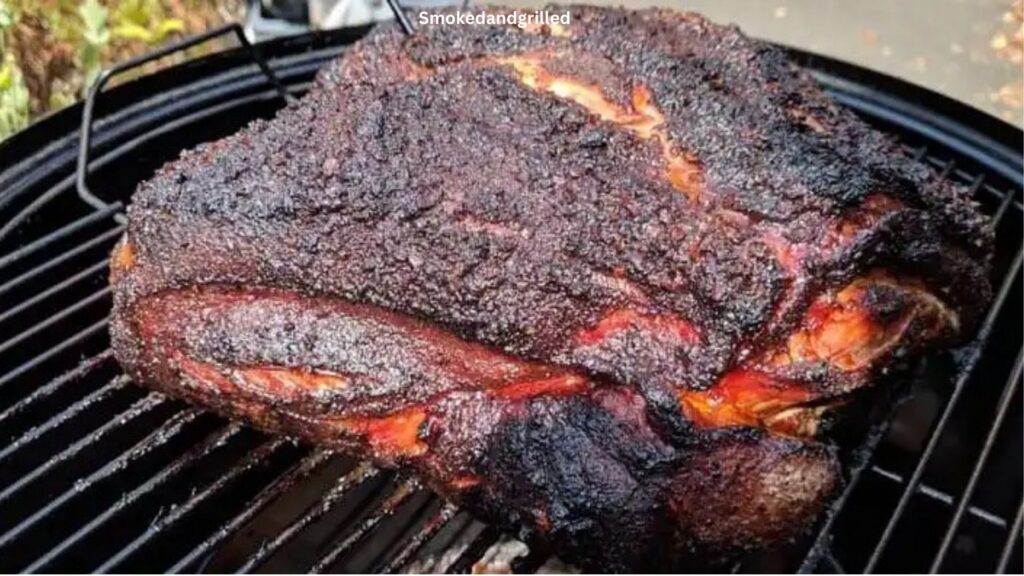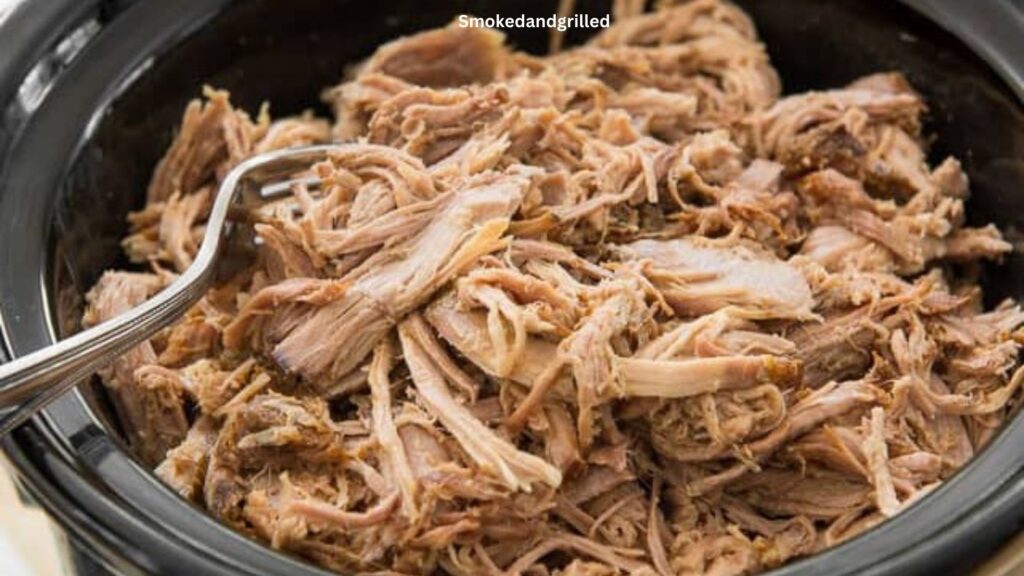Are you looking to make mouth-watering pulled pork? Look no further than the Boston Butt roast.
Whether you’re new to the world of pulled pork or a seasoned pro, using a Boston Butt roast is a surefire way to create a crowd-pleasing dish that will have everyone coming back for seconds.
So, can you use Boston Butt roast for pulled pork? The accurate answer is a resounding yes – and in this article, you’ll learn how to do it right.
Can You Use Boston Butt Roast For Pulled Pork?
Yes, you can use a Boston Butt roast for pulled pork! It’s one of the most popular cuts of pork for making this delicious dish.
Avoid touching the bone while inserting the meat thermometer into the thickest portion of the roast, and check the temperature often as it cooks.
To make pulled pork with a Boston Butt roast, the first step is to prepare the roast for cooking. This usually involves trimming away any excess fat or silver skin from the roast’s outside and applying a dry rub to infuse the meat with flavor.
It’s time to cook the Boston Butt roast after it has been prepped. A Boston Butt roast can be prepared for pulled pork using various techniques, such as smoking, roasting, or slow simmering.
The roast is cooked using the famous smoking technique over a low, indirect fire for several hours, frequently with the addition of wood chunks or chips for flavor. While roasting and smoking have similarities, the former usually entails higher heat and less smoke.
Slow cooking is cooking the roast for several hours in a crockpot or other slow-cooker appliance until it is tender and falling apart.
After the roast has finished cooking, shred the flesh carefully using two forks or a pair of meat-shredding claws. It can be completed quickly with hot meat or after it has cooled. The meat will be sliced and served with your preferred coleslaw, barbecue sauce, or side dishes.
Related Posts:
Why Is Boston Butt Good For Making Pulled Pork?
Rather than the actual butt, a Boston Butt roast originates from the pig’s upper shoulder. Despite having a deceiving name, this cut is perfect for preparing pulled pork because of its high-fat content, which keeps the meat delicious and juicy when cooking.
Additionally, the fat disintegrates while the food cooks, producing tender, juicy meat that shreds quickly for pulled pork. A healthy meat-to-fat ratio in the Boston Butt roast contributes to the pulled pork’s rich, luscious flavor.
It’s a well-liked pig cut for preparing pulled pork, and both pitmasters and home cooks utilize it frequently.
Pork Roast Vs. Pork Shoulder For Pulled Pork?
When making pulled pork, two commonly used pork cuts are the pork roast and the pork shoulder. While both cuts can be used for pulled pork, some differences exist.
Pork roasts are thinner pork cuts taken from the pig’s loin. Being less fatty than pork shoulder makes cooking it more difficult. However, some prefer pig roast for pulled pork because it has a milder flavor and makes the spice stand out more.
Pork shoulder, on the other hand, is a fatty pork cut from the pig’s upper shoulder region. It is also referred to as pork butt.
It cooks more quickly and yields a more tender and tasty final product than hog roast because it has more marbling and connective tissue.
This is due to the breakdown of fat and connective tissue during cooking, which results in rich, juicy meat that shreds quickly for pulled pork.
However, because pork roast is leaner than pork shoulder, it may require more attention and careful monitoring to ensure it stays dry during cooking.
Both pork roast and pork shoulder can be used to make delicious pulled pork, but the choice ultimately comes down to personal preference. If you’re looking for a leaner option that allows the seasoning to shine through, pork roast may be the way to go.
If you’re looking for a richer and more flavorful option, pork shoulder is likely your best bet.
Can I Use A Different Cut Of Pork To Make Pulled Pork, Or Is A Boston Butt Roast The Best Option?
While Boston Butt roast is the most commonly used cut of pork for making pulled pork, other amounts can also be used. However, some cuts may not produce the same flavor and tenderness as a Boston Butt roast.
For instance, pulled pork can be made from pork loin or tenderloin, but these meats are much thinner and may not be as tasty or soft as a Boston Butt roast.
These lean slices must be carefully watched to avoid them from turning rough and dry during cooking since they can quickly dry out.
Pig shoulder roast, or pig butt roast, is an additional choice. This cut is suitable for preparing pulled pork and is comparable to a Boston Butt roast. The heart stays juicy and tender during cooking because of the heart’s good fat-to-meat ratio.
Leaner cuts of meat may benefit from a marinade or infusion to help keep them moist, and they will cook more quickly.
While a Boston Butt roast is the best option for making pulled pork, other pork cuts can also be used.
It’s essential to consider the fat content and cooking method when selecting a cut of pork and to adjust the cooking time and practice as needed to ensure the meat is tender and flavorful.
FAQs
How Should I Prepare A Boston Butt Roast Before Cooking It For Pulled Pork?
Before cooking a Boston Butt roast for pulled pork, there are a few steps you can take to prepare the meat.
First, remove the roast from its packaging and dry it with paper towels. Then, trim any excess fat from the surface of the heart, being careful not to remove too much as the fat will help keep the meat moist during cooking.
Next, evenly coat all sides of the roast with the rub or marinade you choose. Let the roast marinade in the fridge for a few hours or overnight for optimal flavor. Finally, to ensure even cooking, let the roast sit at room temperature for about an hour before cooking.
How Do I Know When The Boston Butt Roast Is Done Cooking?
Avoid touching the bone while inserting the meat thermometer into the thickest portion of the roast, and check the temperature often as it cooks.
Can I Cook A Boston Butt Roast In The Oven Instead Of Using A Smoker Or Grill?
To prepare pulled pork, cook a Boston Butt roast in the oven. Put the seasoned roast in a roasting pan and do your best to get your range to 300°F (149°C) before cooking.
You can also add a tiny bit of liquid to the pan, like apple juice or broth, to keep the meat moist while it cooks.
What Are Some Good Side Dishes To Serve With Pulled Pork?
Many great side dishes pair well with pulled pork. Some popular options include:
- Coleslaw: This classic side dish helps cut through the richness of the pork and adds a nice crunch.
- Baked beans: A sweet and savory side dish that complements the smoky flavor of the pork.
- Cornbread: A classic Southern side dish that goes well with pulled pork.
- Mac and cheese: A creamy, cheesy side dish, always a crowd-pleaser.
- Potato salad: Another classic side dish that pairs well with the pork flavor.
- Grilled vegetables: A healthy and flavorful side dish that can be examined alongside the pork for convenience.
Ultimately, your side dishes will depend on your preferences and the occasion. But these options are a great place to start.
Conclusion
The soft and aromatic flesh of a Boston Butt roast makes it a terrific choice for preparing pulled pork. While other pork cuts can be used, the high-fat content and marbling of the Boston Butt roast make it perfect for slow-cooking techniques like smoking or roasting.
Anyone can produce flavorful and juicy pulled pork using a Boston Butt roast with some planning and attention to the cooking time and temperature. And with various delectable side dishes, this traditional Southern dinner will undoubtedly be a hit for any occasion.
Also Read:



